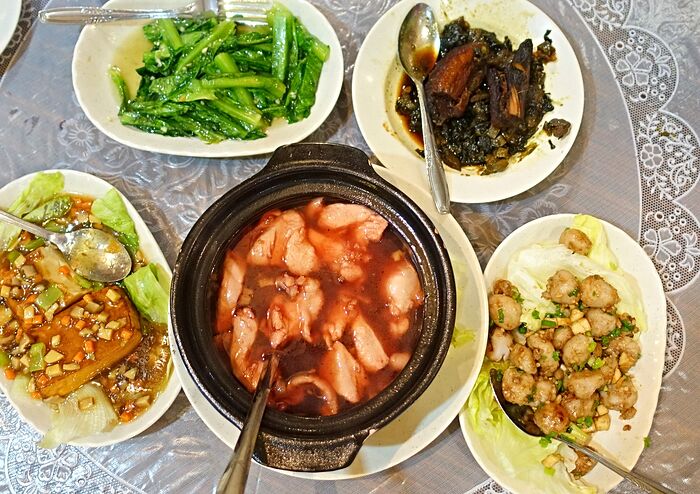Throwback to a family dinner at Plum Village Restaurant on Upper Thomson Road last January.
Plum Village is the last remaining Hakka restaurant in Singapore. It was set up in 1984 by Mr Lai Fak Nian, 72, the Hakka owner-chef who’s very passionate about his Hakka culinary heritage, and has travelled to his family’s ancestral hometown, Meizhou in Guangdong, China, to collect Hakka street food recipes for his restaurant.
The Hakka people’s ancestors originated from Northern China, but were driven southwards because of wars ever since the Qin dynasty (221-206 BC). Since then, the Hakkas are known as the gypsies of China. Labelled in Mandarin as “ke jia ren” (客家人) or the “Guest Families People”, the Hakkas do not have a home province of their own ever since their exodus from the north, but lived as minorities in other provinces, with especially large numbers in Guangdong and Fujian, whilst preserving the integrity of their language and culture. The Hakkas also migrated in large numbers throughout South-east Asia and as far as India, founding the Chinatown in Kolkata, India’s oldest. The Hakka diaspora is estimated to be upwards of 120 million-strong!
Hakka cuisine is pretty rustic, as it reflects their nomadic lifestyle. Our family dinner this evening:
-
Sohn Pan Tzai (算盘子) - “Abacus beads”, made from yam flour, cut into shape of abacus beads, then cooked with minced pork, dried shrimps, cubed tofu & mushrooms.
-
Dung Gong Yam Guk Gai (東江鹽焗雞) - Salt baked chicken.
-
Kiu nyuk (扣肉) - Braised pork belly with preserved mui choy.
-
Ngiong Tew Foo (釀豆腐) - Hakka tofu stuffed with minced pork & fish paste, then braised in brown sauce.
-
Chicken red wine soup - this is more Foochow than Hakka, which has its own chicken in yellow wine soup. I didn’t ask them about this dish’s peculiarity.
-
Stir-fried choy sum
-
Sweet potato in brown sugar and ginger soup.
I really wanted to like Plum Village - after all, the founder of modern Singapore and its first Prime Minister, Lee Kuan Yew, was a Hakka himself. It’s unthinkable for Singapore not to have a Hakka restaurant, among its plethora of thousands of Chinese restaurants in the city: spanning from Cantonese to Chiuchow (Teochew), Shanghainese, Sichuanese, Hokkien and many more.
But the standard of cooking here at Plum Village seemed to have eroded, as we found out on this most recent visit. I remembered really liking its food back in the 1990s, and even in the early 2010s. The restaurant still packed in quite a crowd - probably regulars or old-timers who patronise it out of familiarity.
Address
Plum Village Restaurant
16 Jalan Leban, off Upper Thomson Road
Singapore 577554
Tel: +65 6458 9005
Opening hours: 11.30am to 2.30pm, 6pm to 10pm
















